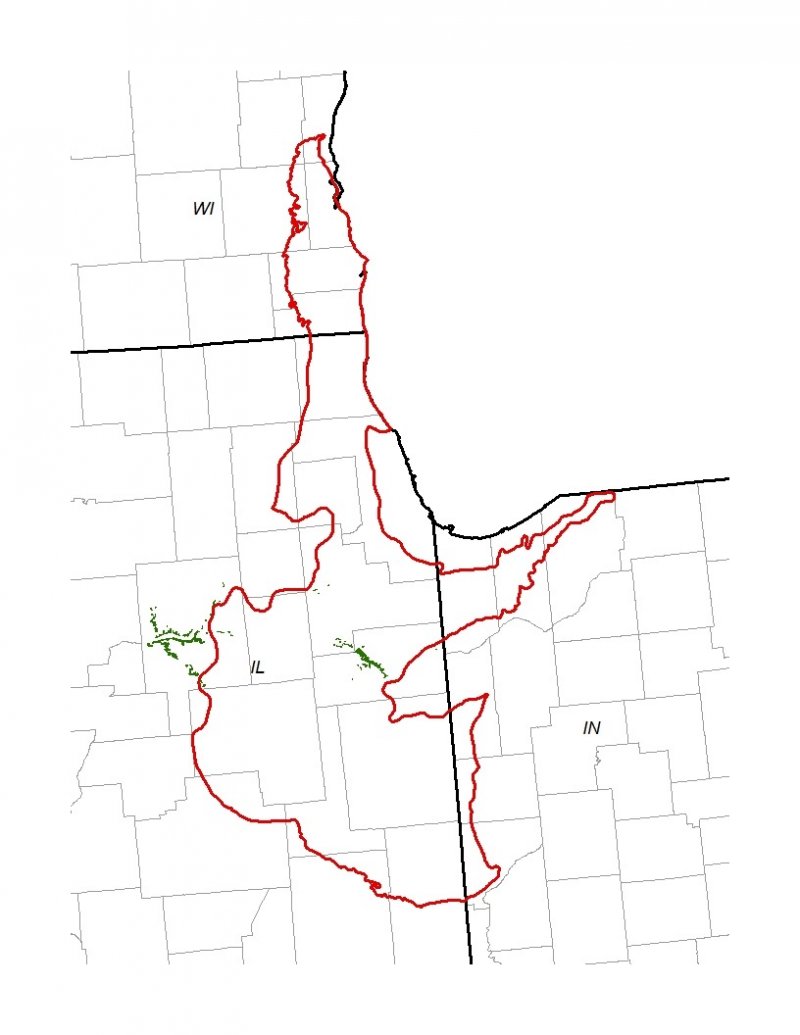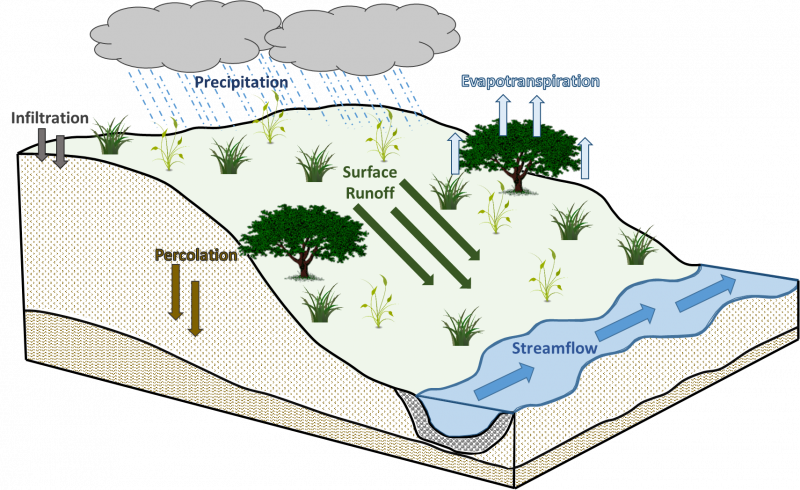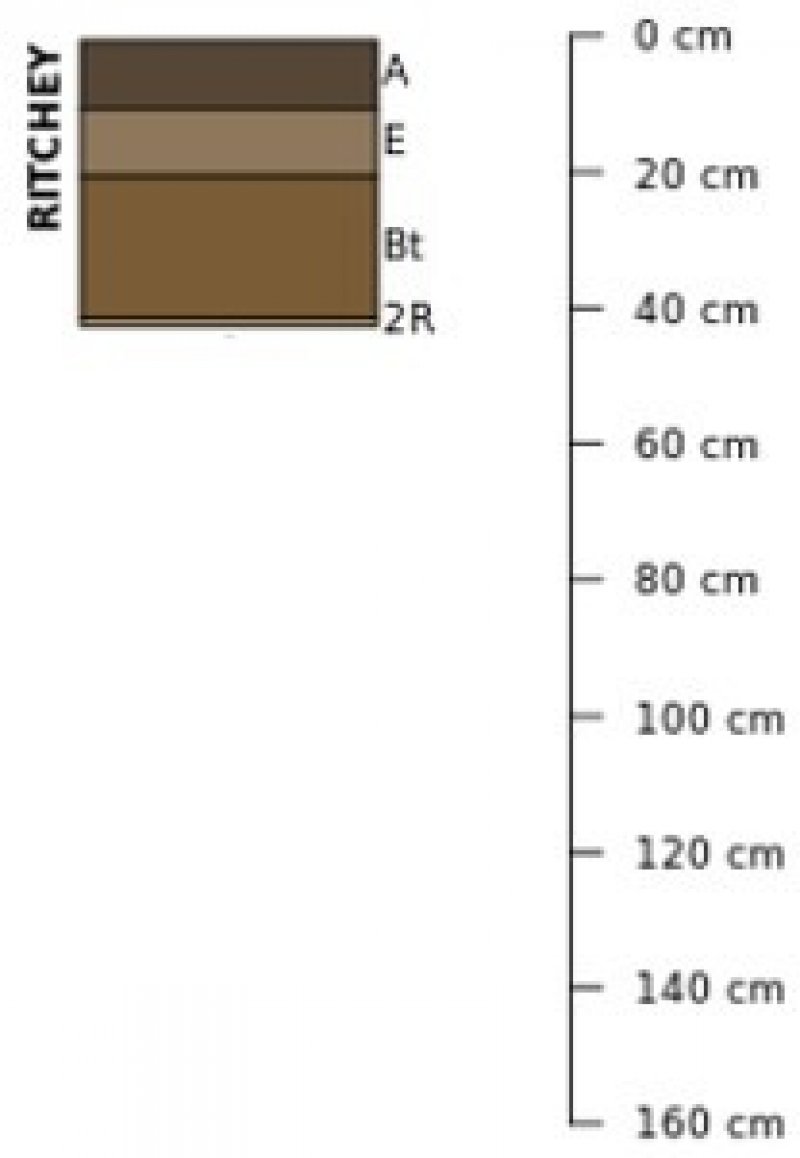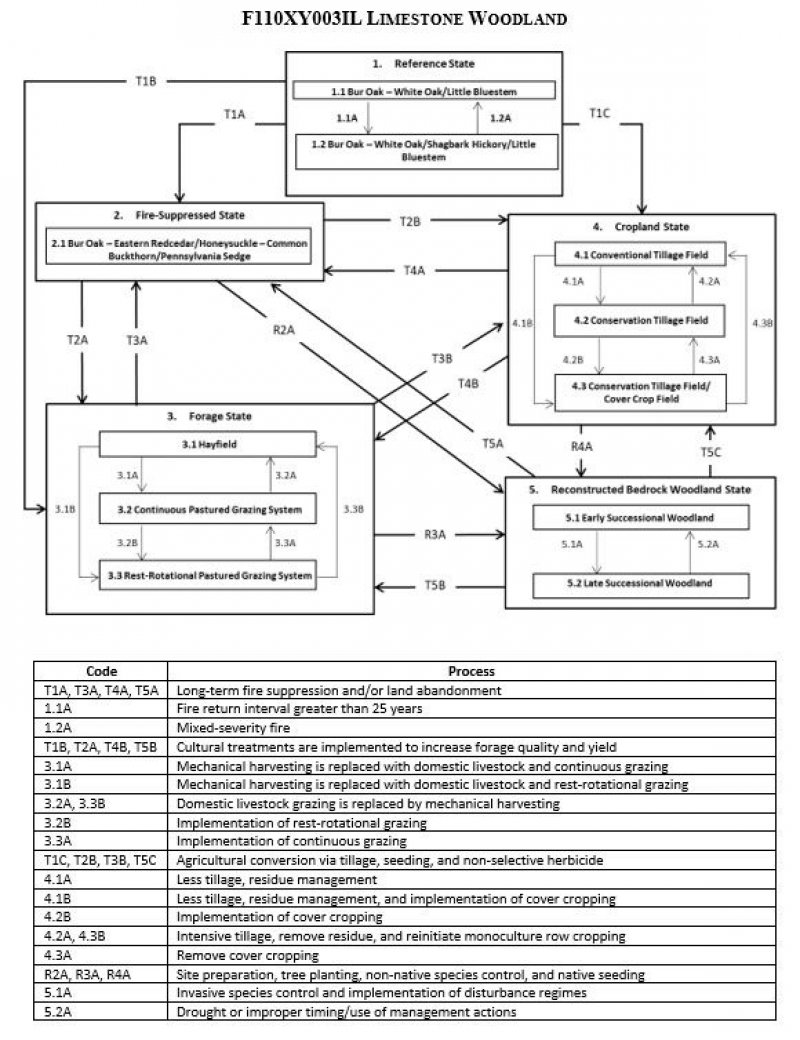Ecological dynamics
The information in this Ecological Site Description, including the state-and-transition model (STM), was developed based on historical data, current field data, professional experience, and a review of the scientific literature. As a result, all possible scenarios or plant species may not be included. Key indicator plant species, disturbances, and ecological processes are described to inform land management decisions.
The MLRA lies within the tallgrass prairie ecosystem of the Midwest, but a variety of environmental and edaphic factors resulted in landscape that historically supported prairies, savannas, forests, and various wetlands. Limestone Woodlands form an aspect of this vegetative continuum. This ecological site occurs on bedrock-controlled uplands on well drained soils. Species characteristic of this ecological site consist of a scrubby, open oak canopy and sparse herbaceous vegetation.
Fire is a critical factor that maintains Limestone Woodlands. Fire typically consisted of low-severity surface fires every 10 years (LANDFIRE 2009). Ignition sources included summertime lightning strikes from convective storms and bimodal, human ignitions during the spring and fall seasons. Native Americans regularly set fires to improve sight lines for hunting, drive large game, improve grazing and browsing habitat, agricultural clearing, and enhance vital ethnobotanical plants (Barrett 1980; LANDFIRE 2009).
Drought and storm damage have also played a role in shaping this ecological site. The periodic episodes of reduced soil moisture in conjunction with the moderately deep soils have favored the proliferation of plant species tolerant of such conditions. Drought can also slow the growth of plants and result in dieback of certain species. Damage to trees from storms and pest outbreaks can vary from minor, patchy effects of individual trees to stand effects that temporarily affect community structure and species richness and diversity (Irland 2000; Peterson 2000). When coupled with fire, periods of drought and catastrophic storm damage can greatly delay the establishment and maturation of woody vegetation (Pyne et al. 1996).
Today, Limestone Woodlands have been reduced from their pre-settlement extent. Low to moderate slopes have been converted to cropland, while steeper slopes have been converted to forage land. Remnants that do exist have experienced long-term fire suppression and overbrowsing resulting in significant changes to the forest structure. A return to the historic plant community may not be possible following extensive land modification, but long-term conservation agriculture or forest reconstruction efforts can help to restore some biotic diversity and ecological function. The state-and-transition model that follows provides a detailed description of each state, community phase, pathway, and transition. This model is based on available experimental research, field observations, literature reviews, professional consensus, and interpretations.
State 1
Reference State
The reference plant community is categorized as a barren community, dominated by scrubby woody and herbaceous vegetation. The two community phases within the reference state are dependent on a combination of surface, mixed, and replacement fires. Low intensity surface fires are the dominant fire regime, comprising more than 80 percent of all fires and occurring every 2 to 7 years. Mixed and replacement fires comprise the remaining 20 percent, occurring approximately every 88 and 37 years, respectively (LANDFIRE 2009). Fire intensity and return intervals alter species composition, cover, and extent, while regular fire intervals keep woody species from closing the canopy. Episodic droughts and storm damage have more localized impacts in the reference phases, but do contribute to overall species composition, diversity, cover, and productivity.
Community 1.1
Bur Oak - White Oak/Little Bluestem
Sites in this reference community phase are an open canopy woodland. Bur oak and white oak are the dominant trees on the site. Trees are medium (9 to 21-inch DBH), and heights are less than 30 feet tall (LANDFIRE 2009). The herbaceous layer can be sparse with grasses and forbs less than 3 feet tall, including little bluestem, poverty oatgrass (Danthonia spicata (L.) P.Beauv. ex Roem. & Schult.), bastard toadflax (Comandra umbellata (L.) Nutt. ssp. umbellata), and wild quinine (Parthenium integrifolium L.) (White and Madany 1978). Surface fires every 10 years will maintain this community phase, but an extended fire return interval will shift the community to phase 1.2 (LANDFIRE 2009).
Community 1.2
Bur Oak - White Oak/Shagbark Hickory/Little Bluestem
This reference community phase represents a fire return interval greater than 25 years. Bur oak and white oak remain the canopy dominant, but shagbark hickory (Carya ovata (Mill.) K. Koch) can begin to become prominent in the subcanopy. Tree size class remains medium due to stunting from the shallow rooting depth and acidic soil conditions. Surface fires every 10 years will maintain this community phase, but a mixed-severity fire will shift the community back to phase 1.1 (LANDFIRE 2009).
Pathway 1.1A
Community 1.1 to 1.2
Fire return interval greater than 25 years.
Pathway 1.2A
Community 1.2 to 1.1
Mixed-severity fire event.
State 2
Fire-Suppressed Forest State
Fire suppression can transition the reference plant community from an oak forest to an oak-maple mesophytic forest. As the natural fire regime is removed from the landscape, encroachment and dominance by shade-tolerant, fire-intolerant species ensues. This results in a positive feedback loop of mesophication whereby plant community succession continuously creates cool, damp shaded conditions that perpetuate a closed canopy ecosystem (Nowacki and Abrams 2008). Succession to this forested state can occur in as little as 80 years from the last fire (LANDFIRE 2009).
Community 2.1
Bur Oak - Eastern Redcedar/Honeysuckle - Common Buckthorn/Pennsylvania Sedge
This community phase represents the early stages of long-term fire suppression. Mature, scrubby oaks and shagbark hickory are still present, but the fire-intolerant eastern redcedar (Juniperus virginiana L.) begins to co-dominate in the prolonged absence of fire. The tree canopy closes to 100 percent cover and basal area increases (LANDFIRE 2009). Non-native shrubs, such as honeysuckle (Lonicera L.) and common buckthorn (Rhamnus cathartica L.), can rapidly colonize. The herbaceous layer shifts to shade-tolerant species, and diversity is reduced.
State 3
Forage State
The forage state occurs when the reference state is converted to a farming system that emphasizes domestic livestock production known as grassland agriculture. Fire suppression, periodic cultural treatments (e.g., clipping, drainage, soil amendment applications, planting new species and/or cultivars, mechanical harvesting) and grazing by domesticated livestock transition and maintain this state (USDA-NRCS 2003). Early settlers seeded non-native species, such as smooth brome (Bromus inermis Leyss.) and Kentucky bluegrass (Poa pratensis L.), to help extend the grazing season. Over time, as lands were continuously harvested or grazed by herds of cattle, the non-native species were able to spread and expand across the landscape, reducing the native species diversity and ecological function.
Community 3.1
Hayfield
Sites in this community phase consist of forage plants that are planted and mechanically harvested. Mechanical harvesting removes much of the aboveground biomass and nutrients that feed the soil microorganisms (Franzluebbers et al. 2000; USDA-NRCS 2003). As a result, soil biology is reduced leading to decreases in nutrient uptake by plants, soil organic matter, and soil aggregation. Frequent biomass removal can also reduce the site’s carbon sequestration capacity (Skinner 2008).
Community 3.2
Continuous Pastured Grazing System
This community phase is characterized by continuous grazing where domestic livestock graze a pasture for the entire season. Depending on stocking density, this can result in lower forage quality and productivity, weed invasions, and uneven pasture use. Continuous grazing can also increase the amount of bare ground and erosion and reduce soil organic matter, cation exchange capacity, water-holding capacity, and nutrient availability and retention (Bharati et al. 2002; Leake et al. 2004; Teague et al. 2011). Smooth brome, Kentucky bluegrass, and white clover (Trifolium repens L.) are common pasture species used in this phase. Their tolerance to continuous grazing has allowed these species to dominate, sometimes completely excluding the native vegetation.
Community 3.3
Rest-Rotation Pastured Grazing System
This community phase is characterized by rotational grazing where the pasture has been subdivided into several smaller paddocks. Through the development of a grazing plan, livestock utilize one or a few paddocks, while the remaining area is rested allowing plants to restore vigor and energy reserves, deepen root systems, develop seeds, as well as allow seedling establishment (Undersander et al. 2002; USDA-NRCS 2003). Rest-rotation pastured grazing systems include deferred rotation, rest rotation, high intensity – low frequency, and short duration methods. Vegetation is generally more diverse and can include orchardgrass (Dactylis glomerata L.), timothy (Phleum pretense L.), red clover (Trifolium pratense L.), and alfalfa (Medicago sativa L.). The addition of native prairie species can further bolster plant diversity and, in turn, soil function. This community phase promotes numerous ecosystem benefits including increasing biodiversity, preventing soil erosion, maintaining and enhancing soil quality, sequestering atmospheric carbon, and improving water yield and quality (USDA-NRCS 2003).
Pathway 3.1A
Community 3.1 to 3.2
Mechanical harvesting is replaced with domestic livestock utilizing continuous grazing.
Pathway 3.1B
Community 3.1 to 3.3
Mechanical harvesting is replaced with domestic livestock utilizing rotational grazing.
Pathway 3.2A
Community 3.2 to 3.1
Domestic livestock are removed, and mechanical harvesting is implemented.
Pathway 3.2B
Community 3.2 to 3.3
Rotational grazing replaces continuous grazing.
Pathway 3.3B
Community 3.3 to 3.1
Domestic livestock are removed, and mechanical harvesting is implemented.
Pathway 3.3A
Community 3.3 to 3.2
Continuous grazing replaces rotational grazing.
State 4
Cropland State
The continuous use of tillage, row-crop planting, and chemicals (i.e., herbicides, fertilizers, etc.) has effectively eliminated the reference community and many of its natural ecological functions in favor of crop production. Corn and soybeans are the dominant crops for the site, and oats (Avena L.) and alfalfa (Medicago sativa L.) may be rotated periodically. These areas are likely to remain in crop production for the foreseeable future.
Community 4.1
Conventional Tillage Field
Sites in this community phase typically consist of monoculture row-cropping maintained by conventional tillage practices. They are cropped in either continuous corn or corn-soybean rotations. The frequent use of deep tillage, low crop diversity, and bare soil conditions during the non-growing season negatively impacts soil health. Under these practices, soil aggregation is reduced or destroyed, soil organic matter is reduced, erosion and runoff are increased, and infiltration is decreased, which can ultimately lead to undesirable changes in the hydrology of the watershed (Tomer et al. 2005).
Community 4.2
Conservation Tillage Field
This community phase is characterized by rotational crop production that utilizes various conservation tillage methods to promote soil health and reduce erosion. Conservation tillage methods include strip-till, ridge-till, vertical-till, or no-till planting systems. Strip-till keeps seedbed preparation to narrow bands less than one-third the width of the row where crop residue and soil consolidation are left undisturbed in-between seedbed areas. Strip-till planting may be completed in the fall and nutrient application either occurs simultaneously or at the time of planting. Ridge-till uses specialized equipment to create ridges in the seedbed and vegetative residue is left on the surface in between the ridges. Weeds are controlled with herbicides and/or cultivation, seedbed ridges are rebuilt during cultivation, and soils are left undisturbed from harvest to planting. Vertical-till systems employ machinery that lightly tills the soil and cuts up crop residue, mixing some of the residue into the top few inches of the soil while leaving a large portion on the surface. No-till management is the most conservative, disturbing soils only at the time of planting and fertilizer application. Compared to conventional tillage systems, conservation tillage methods can improve soil ecosystem function by reducing soil erosion, increasing organic matter and water availability, improving water quality, and reducing soil compaction.
Community 4.3
Conservation Tillage Field/Alternative Crop Field
This community phase applies conservation tillage methods as described above as well as adds cover crop practices. Cover crops typically include nitrogen-fixing species (e.g., legumes), small grains (e.g., rye, wheat, oats), or forage covers (e.g., turnips, radishes, rapeseed). The addition of cover crops not only adds plant diversity but also promotes soil health by reducing soil erosion, limiting nitrogen leaching, suppressing weeds, increasing soil organic matter, and improving the overall soil ecosystem. In the case of small grain cover crops, surface cover and water infiltration are increased, while forage covers can be used to graze livestock or support local wildlife. Of the three community phases for this state, this phase promotes the greatest soil sustainability and improves ecological functioning within a cropland system.
Pathway 4.1A
Community 4.1 to 4.2
Tillage operations are greatly reduced, crop rotation occurs on a regular interval, and crop residue remains on the soil surface.
Pathway 4.1B
Community 4.1 to 4.3
Tillage operations are greatly reduced or eliminated, crop rotation occurs on a regular interval, crop residue remains on the soil surface, and cover crops are planted following crop harvest.
Pathway 4.2A
Community 4.2 to 4.1
Intensive tillage is utilized, and monoculture row-cropping is established.
Pathway 4.2B
Community 4.2 to 4.3
Cover crops are implemented to minimize soil erosion.
Pathway 4.3B
Community 4.3 to 4.1
Intensive tillage is utilized, cover crop practices are abandoned, monoculture row-cropping is established, and crop rotation is reduced or eliminated.
Pathway 4.3A
Community 4.3 to 4.2
Cover crop practices are abandoned.
State 5
Reconstructed Bedrock Woodland State
The combination of natural and anthropogenic disturbances occurring today has resulted in numerous forest health issues, and restoration back to the historic reference condition may not be possible. Woodlands are being stressed by non-native diseases and pests, habitat fragmentation, changes in soil conditions, and overabundant deer populations on top of naturally occurring disturbances (severe weather and native pests) (IFDC 2018). However, these habitats provide multiple ecosystem services including carbon sequestration; clean air and water; soil conservation; biodiversity support; wildlife habitat; timber, fiber, and fuel products; as well as a variety of cultural activities (e.g., hiking, camping, hunting) (Millennium Ecosystem Assessment 2005; IFDC 2018). Therefore, conservation of woodlands should still be pursued. Woodland reconstructions are an important tool for repairing natural ecological functioning and providing habitat protection for numerous species associated with Limestone Woodlands. Therefore, ecological restoration should aim to aid the recovery of degraded, damaged, or destroyed ecosystems. A successful restoration will have the ability to structurally and functionally sustain itself, demonstrate resilience to the ranges of stress and disturbance, and create and maintain positive biotic and abiotic interactions (SER 2002). The reconstructed bedrock woodland state is the result of a long-term commitment involving a multi-step, adaptive management process.
Community 5.1
Early Successional Reconstructed Woodland
This community phase represents the early community assembly from woodland reconstruction. It is highly dependent on the current condition of the site based on past and current land management actions, invasive species, and proximity to land populated with non-native pests and diseases. Therefore, no two sites will have the same early successional composition. Technical forestry assistance should be sought to develop suitable conservation management plans.
Community 5.2
Late Successional Reconstructed Woodland
Appropriately timed management practices (e.g., prescribed fire, hazardous fuels management, forest stand improvement, continuing integrated pest management) applied to the early successional community phase can help increase the stand maturity, pushing the site into a late successional community phase over time. A late successional reconstructed woodland will have an uneven-aged canopy with a sparse, short herbaceous understory.
Pathway 5.1A
Community 5.1 to 5.2
Application of stand improvement practices in line with a developed management plan.
Pathway 5.2A
Community 5.2 to 5.1
Reconstruction experiences a setback from extreme weather event or improper timing of management actions.
Transition T1A
State 1 to 2
Long-term fire suppression in excess of 80 years transitions the site to the fire-suppressed forest state (2).
Transition T1B
State 1 to 3
Cultural treatments to enhance forage quality and yield transitions the site to the forage state (3).
Transition T1C
State 1 to 4
Tillage, seeding of agricultural crops, and non-selective herbicide transition this site to the cropland state (4).
Transition T2A
State 2 to 3
Cultural treatments to enhance forage quality and yield transitions the site to the forage state (3).
Transition T2B
State 2 to 4
Tillage, seeding of agricultural crops, and non-selective herbicide transition this site to the cropland state (4).
Restoration pathway R2A
State 2 to 5
Site preparation, tree planting, invasive species control, seeding native species, and deer management transition this site to the reconstructed bedrock woodland state (5).
Transition T3A
State 3 to 2
Land abandonment transitions the site to the fire-suppressed forest state (2).
Transition T3B
State 3 to 4
Tillage, seeding of agricultural crops, and non-selective herbicide transition this site to the cropland state (4).
Restoration pathway R3A
State 3 to 5
Site preparation, tree planting, invasive species control, and seeding native species transition this site to the reconstructed bedrock woodland state (5).
Transition T4A
State 4 to 2
Land abandonment transitions the site to the fire-suppressed forest state (2).
Transition T4B
State 4 to 3
Cultural treatments to enhance forage quality and yield transitions the site to the forage state (3).
Restoration pathway R4A
State 4 to 5
Site preparation, tree planting, invasive species control, and seeding native species transition this site to the reconstructed bedrock woodland state (5).
Transition T5A
State 5 to 2
Fire suppression and removal of active management transitions this site to the fire-suppressed forest state (2).
Transition T5B
State 5 to 3
Cultural treatments to enhance forage quality and yield transition the site to the forage state (3).
Transition T5C
State 5 to 4
Tillage, seeding of agricultural crops, and non-selective herbicide transition this site to the cropland state (4).




